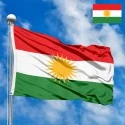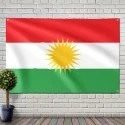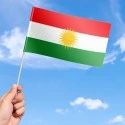Flag of the Kurds
- Flag Type: Ethnic
- Proportions (official): 2:3
- Population: 35,000,000 - 40,000,000 (2024, estimate)
Flag Information
Demography and Culture
- All Flags
- Flags of Countries by Continent
-
Flags of Organizations
- Flags of UN countries
- Flags of the European Union countries
- Flags of NATO countries
- Flags of the countries of the Organization of Islamic Cooperation
- Flags of the countries of the Organization of American States
- Flags of the Arab League countries
- Flags of the African Union countries
- Flags of the countries of the Union of South American Nations
- Flags of the Commonwealth of Nations
- Flags of the countries of the Secretariat of the Pacific Community
- Flags of the Nordic Council countries
- Flags of the Caribbean Community
- Flags of the countries of the Association of Southeast Asian Nations
- Flags of the East African Community
- Flags of the countries of the Organization of Turkic States
- LGBT Community Flags
- Historical Flags
- Ethnic Flags
- Flags of the USA (states)
Description
The Kurdish flag, known as Ala Rengîn (The Colorful Flag), is a powerful and unifying symbol of the Kurdish people's identity, national aspirations, and centuries-long struggle for freedom and dignity. More than just a national emblem, it is a beacon of hope and a testament to the resilience of a people without a sovereign state of their own. Its design is rich in historical and cultural significance, representing the geography, history, and spiritual heritage of Kurdistan.
Design and Symbolism
The Kurdish flag consists of three horizontal stripes of equal width, with a central emblem of a golden sun. The order of the colors from top to bottom is red, white, and green.
-
The Red Stripe: The top red stripe symbolizes the blood of Kurdish martyrs and the continuous struggle for the freedom and independence of Kurdistan. It is a testament to the sacrifices made for the nation's existence and dignity.
-
The White Stripe: The middle white stripe represents peace, equality, and the desire for a harmonious future. It embodies the Kurdish people's peaceful nature and their hope for a life free from violence and oppression.
-
The Green Stripe: The bottom green stripe signifies the vibrant, fertile landscapes of Kurdistan. It symbolizes the beauty of its mountains, valleys, and forests, representing the life and vitality of the homeland.
-
The Golden Sun: At the center of the flag is a golden sun emblem with 21 rays. The sun is a central symbol in ancient Kurdish and pre-Islamic mythology, representing light, knowledge, hope, and freedom. The number 21 is especially significant; it is a sacred number in Yazdanism, one of the indigenous Kurdish religions, and it coincides with the spring equinox, Newroz, which is the Kurdish New Year. Newroz is a festival of rebirth, resistance, and freedom.
History of Creation and Adoption
The roots of the Kurdish flag's design can be traced back to the early 20th century. A similar flag was used by the short-lived Republic of Ararat in 1927, which was a Kurdish statelet in eastern Turkey. The modern version of the flag is widely credited to be designed by the organization Xoybûn and notably associated with the artistry of Emir Kamuran Bedir Khan.
While the flag was suppressed in many regions, it was officially adopted by the Kurdistan Regional Government (KRG) in the autonomous region of northern Iraq in 1992. This adoption marked a crucial moment of political recognition and self-governance for the Kurdish people in Iraq. Since then, it has become the universally recognized national flag for Kurds across all parts of Kurdistan and the global diaspora.
Flag Size and Proportions
The Kurdish flag is generally created with a height-to-width ratio of 2:3. The sun emblem in the center is carefully proportioned to occupy a central position without touching the colored stripes. Its diameter is typically determined by the width of the flag, ensuring a balanced and prominent appearance.
The People, their Region, and the Flag's Significance
Kurdistan is a geographical and cultural region spanning parts of Turkey, Iraq, Iran, and Syria, which has been the ancestral homeland of the Kurdish people for millennia. The flag represents the unity and national identity of Kurds across these fragmented regions and the large global diaspora. It is a vital symbol for a people who have endured centuries of persecution, cultural suppression, and genocide. For Kurds, the flag embodies not just their rich heritage but also their political aspirations for autonomy and self-determination. It is a powerful reminder that despite political divisions and forced displacement, the Kurdish nation remains united by its shared history, language, and culture.
Interesting Facts
-
The Kurdish flag is often displayed on Newroz, the spring equinox, which is the most important festival in Kurdish culture, symbolizing rebirth, resilience, and the triumph of light over darkness.
-
The number 21 in the sun's rays is a key element, linking the flag to ancient spiritual beliefs and the Newroz festival, which holds deep national and symbolic meaning.
-
Although it is the official flag of the Kurdistan Regional Government in Iraq, its emotional and political significance transcends these borders, making it a powerful symbol for all Kurds, regardless of their location.
-
The flag’s vibrant colors and central sun emblem are designed to be immediately recognizable, serving as a powerful visual rallying point for Kurds worldwide.
In summary, the Kurdish flag is a deeply meaningful and enduring symbol that encapsulates the identity, history, and national aspirations of a people who have steadfastly preserved their culture and spirit despite immense challenges.
In the demonstration images, full-size flags are shown with proportions of 2:3, and hand-held flags with proportions of 1:2.
Donation
Download
Completely free for commercial and non-commercial use (public domain).
You can freely use them in your news magazines, websites, software, mobile applications.
We appreciate a backlink to https://flagssite.com
Raster files - Flag of the Kurds (PNG, JPG)
 Waving flag
Waving flag
- PNG format (transparent background), 72dpi, dimensions in Pixels (px), aspect ratio 3:4.
- 15х20 px
- 30х40 px
- 60х80 px
- 120x160 px
- 240x320 px
 Sizes:
Sizes:
"v15" - image size (by height); if necessary, replace with available: v15, v30, v60, v120, v240.
!!! For resizing, use the Latin (eng) keyboard layout.
<img src="https://flagssite.com/flags/v15/20903.png" alt="Flag of the Kurds">
 Round flag
Round flag
- PNG format (transparent background), 72dpi, dimensions in Pixels (px), aspect ratio 1:1.
"d15" - image size (diameter); if necessary, replace with available: d15, d30, d60, d120, d240.
!!! For resizing, use the Latin (eng) keyboard layout.
<img src="https://flagssite.com/flags/d15/20903.png" alt="Flag of the Kurds">
 Rectangular flag 2:3
Rectangular flag 2:3
- JPG format, 72dpi, dimensions in Pixels (px), aspect ratio 2:3.
"h30" - image size (by height); if necessary, replace with available: h15, h30, h60, h120, h240, h360, h480.
!!! For resizing, use the Latin (eng) keyboard layout.
<img src="https://flagssite.com/flags/h30/20903.jpg" alt="Flag of the Kurds">












 Sizes:
Sizes:
 Sizes:
Sizes: